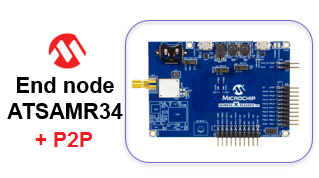Introduction
Get the Microchip ATSAMR34 Xplained Pro evaluation kits
Software Installation
Hardware Installation
Simple LoRa Peer-to-Peer Application
LoRa Peer-to-Peer + LoRaWAN in a single Application
MiWi Simple P2P on top of LoRa Radio
Introduction
LoRa is a radio Physical layer (PHY) modulation technology focusing on battery-powered endpoints over long-range radio connectivity. It offers long air propagation distance, low power consumption, high receiving sensitivity, low data rates, robust spectrum spreading, and secured encryption transmission.
LoRaWAN is a Media Access Layer (MAC) protocol specification defined and maintained by the LoRa Alliance on top of the LoRa radio physical layer. It characterizes the device-to-infrastructure (LoRa®) physical layer parameters & (LoRaWAN™) protocol and so provides seamless interoperability between manufacturers. It is designed to scale from a single gateway infrastructure up to large global networks with many devices. A LoRaWAN network architecture is deployed in a star-of-stars topology in which gateways relay messages between end-devices and a central network server.
A peer-to-peer communication using LoRa technology allows a direct communication and long-distance between 2 devices. This is particularly useful in restrained environment where global LoraWAN infrastructure is not needed or simply not available. Or in a hybrid infrastructure, where some devices will be set to only communicate thru peer to peer (low latency, low Opex) while others will also be connected to LoraWAN infrastructure (gateway).
There are many applications for peer to peer Lora connectivity taking full advantage of the Long-range and low power characteristics of Lora technology. It includes garage door-opener (GDO), smart home or industrial smart sensors, alarm systems, commissioning of LoraWAN network.
Last but not least, the high-link budget offers a 30-dB improvement over FSK to reject co-channel interference and delivers power consumption seven times lower to minimize operational cost. This makes LoRa a viable option for increasing efficiency across a very wide range of applications.
Different peer-to-peer examples illustrate the various application of the LoRa technology embedded insider the ATSAMR34.
More information on this product could also be found here :
https://www.microchip.com/design-centers/wireless-connectivity/low-power-wide-area-networks/lora-technology/sam-r34-r35










